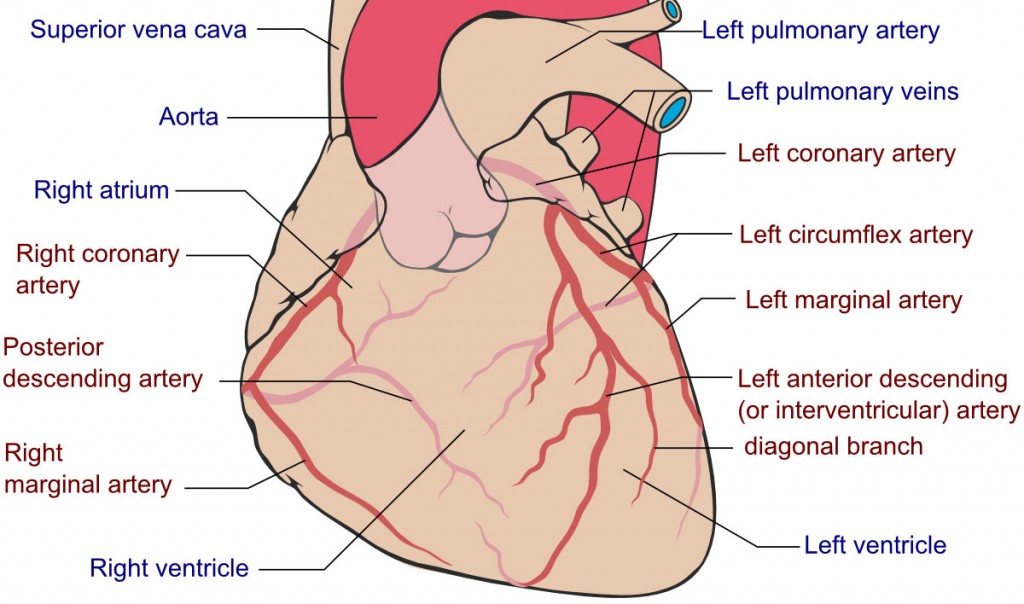Coronary Artery Disease – an Overview
 The coronary arteries supply the muscles of the heart (myocardium) with oxygen-rich blood allowing it to function properly and efficiently. Two main coronary arteries that originate at the root of the aorta, along with its branches, provide the heart muscle with its entire blood supply.
The coronary arteries supply the muscles of the heart (myocardium) with oxygen-rich blood allowing it to function properly and efficiently. Two main coronary arteries that originate at the root of the aorta, along with its branches, provide the heart muscle with its entire blood supply.
The Right Coronary Artery (RCA) branches into the Right Marginal Artery and the Posterior Descending Artery. The RCA network supplies blood to the right atrium, the right ventricle, the bottom of the right and left ventricles and the back of the septum.
The Left Coronary Artery (LCA) branches into the Left Circumflex Artery, which provides oxygen-rich blood to the left atrium and the side and back of the left ventricle. Also branching from the Left Coronary Artery is the Left Anterior Descending Artery (LAD). Commonly known as “The Widow Maker” in certain circumstances, the LAD supplies blood to the bottom of the left ventricle and the front of the septum. If the LAD becomes significantly blocked, a patient runs a much higher risk of suffering emergent myocardial infarction (heart attack) than with any other isolated coronary artery blockage.
Coronary Artery Disease (CAD) is a condition in which the coronary arteries become narrowed as a result of atherosclerosis – the build up of plaque within the arteries that results in restricted blood flow (Myocardial Ischemia). Restricted blood flow through the coronary arteries is a dangerous condition that results in oxygen deprivation of the heart muscle. Prolonged oxygen deprivation can lead to angina (chest pain), myocardial infarction (heart attack), and irreparable damage to the heart muscle or even death.
Coronary artery disease is the most prevalent type of heart disease, with men carrying a greater risk, and is the leading cause of death amongst men and women in the United States. Risk factors for CAD include increased age, high cholesterol, high blood pressure, smoking, physical inactivity, obesity, diabetes and hereditary factors.
Coronary Artery Bypass Grafting (CABG)
Coronary Artery Bypass Grafting (CABG) is a surgical procedure in which one or more restricted coronary arteries are bypassed by a blood vessel graft in order to restore healthy blood flow to the heart. The blood vessels most commonly used for bypass are from the patient’s chest wall (mammary artery), leg (saphenous vein) or arm (radial artery). Once the vessel is harvested, one end is attached to the coronary artery beyond the site of the blockage, while the other is attached to the aorta. When using the patient’s mammary artery, which originates from the aorta, the artery is simply detached from the patient’s chest wall and attached to the coronary artery beyond the site of the blockage. The graft creates a new pathway for oxygenated blood flow to the heart muscle.
Coronary Artery Bypass Grafting is the most commonly performed surgical procedure in the United States, with nearly half a million performed annually. CTVS surgeons perform approximately 1000 CABG procedures in Central Texas each year, including traditional open surgery through sternotomy, off-pump (still-beating heart) CABG, minimally-invasive CABG and robotically-assisted CABG.
During open CABG surgery, the surgeon makes an 8- to 12-inch incision down the center of the chest and separates the sternum with a retractor to expose the heart. The patient is then placed on cardiopulmonary bypass (CPB) by placing canulae in various chambers of the heart and vessels leading to and from the heart. The CPB temporarily takes over the function of the heart and lungs so the heart can be stopped in order to achieve the bypass grafting. The surgery can take anywhere from 2-4 hours depending on the number of coronary arteries being bypassed.
In some cases, it is not necessary to stop the heart in order to perform the bypass graft. Indications for this approach may be a single-vessel bypass procedure using the patients Left Internal Mammary Artery (LIMA). When performing beating-heart CABG, the patient does not require CPB.
